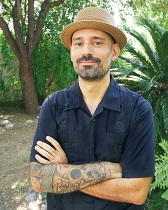2023-2024 Colloquia
October 16th
Maurice Magaña
University of Arizona
Multimodal Archives and Multi-sited Prescence: Cultural Production, Intergenerational Activism, and Belonging in Diasporic Communities
This paper considers the kinds of grassroots archives created by artists and activists who insist on being seen on their own terms. These artists and activists belong to diasporic, racialized communities (Central American, Mexican, Chicanx) in the US and Mexico (Los Angeles, CA and Oaxaca, Mexico). Anchored around the concept of multimodal archives, this paper puts cultural productions like murals, zines, and music (lyrics and videos) in conversation with digital and social media usage, more traditional archival material and ethnographic data to better understand how young people are theorizing radical politics, race, identity, and belonging. These theorizations refuse easy categorization and demand an embrace of the messiness and contradictions involved in collective struggle to create more just worlds where racialized, migrant communities are seen and treated as bring fully human. The archives constituted by such productions and practices link communities, events, and histories across temporal and spatial geographies and scales thus generating rich insights into how artists and activists create and strengthen community across national borders and various categories of difference. Included in this paper will be attention to how these archives link physical and digital sites, ephemerality and permanence to create what I call multi-sited presence.
October 23rd
Sherina Feliciano-santos
University of South Carolina
Regimenting Perceptions: The sensory sign and its racialized trajectories
Regimes of racialized perception and uptake rooted and emergent in and through colonial racial orders are entrenched across scales of interaction ranging from bureaucratic institutions to everyday interpersonal exchanges. These regimes and orders impact the ways that perceivable signs of embodiment ranging from smell and taste, to sight, touch, and sound are expressed, interpreted, and contested, as well as the limits of their interactional expression and interpretation. Drawing on my own work in the U.S. and Puerto Rico and recent research by scholars in anthropology, Caribbean studies, and Carceral studies that consider concepts such as racial orders and rights, saliency and visibility, multi-sensoriality, materiality, and embodiment, as well as raciolinguistic and raciosemiotic approaches to anthropology, I consider the historical emergence of multiple forms of racial-sensorial-perceptual regimentation and the impacts of these different (yet often overlapping) regimented forms of perception within social exchanges. Lastly, I contemplate how official bureaucratic and unofficial quotidian encounters contribute to their hierarchization, re-entrenchment, and contestation.
October 30th
Amahl Bishara
Tufts University
Crossing a Line: Laws, Violence & Roadblocks to Palestinian Political Expression
Palestinian activists who are citizens of Israel and those living under Israeli military occupation in the West Bank assert that they share a single political struggle for national liberation. Yet, obstacles inhibit their ability to speak to each other and as a collective. Geopolitical boundaries fragment Palestinians into ever smaller groups. Through ethnography, Bishara enters these distinct environments for political expression and action of Palestinians who carry Israeli citizenship and Palestinians subject to Israeli military occupation in the West Bank, and considers how Palestinians are differently impacted by dispossession, settler colonialism, and militarism. Bishara looks to sites of political practice—journalism, historical commemorations, street demonstrations, social media, in prison, and on the road—to analyze how Palestinians create collectivities in these varied circumstances. In considering these different environments for political expression and action, Bishara illuminates how expression is always grounded in place—and how a people can struggle together for liberation even when they cannot join together in protest. She also reflects on experiences sharing this work with Palestinian audiences and on how changes in both Palestinian political terrain and decolonizing work in anthropology frame and reframe this work.
January 22nd
Terry Deacon
UC Berkeley
Human Symbolic Nature
February 19th
Kisha Supernant
University of Alberta
From Extraction to Restoration: Heart-centered Archaeology for Reclamation and Restorative Justice
Archaeology in North America has long been associated with colonial, extractive practices, where the materials, landscapes, and bodies of Indigenous and enslaved people were seen as specimens and objects of study. The long-standing and ongoing critique of archaeology by Indigenous and other systemically excluded voices has led to changes, but the harmful legacy of past research has not always been adequately addressed. In this talk, I explore how archaeologists are approaching their research as service to reorient their work toward reclamation and restorative justice. Drawing on case studies from my own work with Indigenous communities in Canada, I explore how taking a heart-centered approach can transform archaeology from an extractive practice to a restorative one and create a safer, more just future for the discipline and for the world.
February 26th
Anna Agbe-Davies
University of North Carolina
Rights work made material: An archaeology of the Phyllis Wheatley Home for Girls, Chicago.
The civil rights movement of the 20th century is often understood in terms of singular, historic events and politically-prominent (often male) protagonists; archaeology offers a new lens on this critical moment in US history. Artifacts and archives associated with African American women engaged in the struggle for equal rights reveal how the demands of daily life both reflected and shaped their efforts. The larger book project considers two archaeological sites—one institutional and one family-owned, one in Chicago and one in the Piedmont of North Carolina. Both represent households run by and occupied by women, allowing a focus on their specific perspectives and experiences.
April 8th
Ripan Malhi
University of Illinois
Changing the practice and practitioners of anthropological genomics
Anthropological genomics has its roots in the field of physical anthropology which has a long history of extractive research and colonial science, some of which continues today.
The field has recently taken ethical steps to acknowledge its racist origins and is working to change this legacy. In this presentation, I discuss developing training programs for students in the social and life sciences as well as my evolving research program in anthropological genomics towards more equitable and inclusive practices.
Ripan S. Malhi is Professor at the University of Illinois at Urbana-Champaign with affiliations in Anthropology, School of Integrative Biology, American Indian Studies and the Carl R. Woese Institute for Genomic Biology. Dr. Malhi is Co-Director of the Center for Indigenous Science and his research areas include using genomics as a tool to learn about evolutionary histories in the Americas as well as the impacts of European colonization on Indigenous peoples of North America. Along with his research, Dr. Malhi uses his time to help make scientific research more inclusive. He co-founded the Summer internship for INdigenous peoples in Genomics (SING) USA program and the Increasing Diversity in Evolutionary Anthropological Studies (IDEAS) program. Prior to his position at University of Illinois, he co-founded and served as the CEO of Trace Genetics, Inc., a biotechnology company located in the greater San Francisco area. Dr. Malhi received his Ph.D. in Anthropology from the University of California at Davis.
April 15th
Xochitl Marsilli-Vargas
Emory University
“That’s not what you mean”: Intention, poetics and resonance in the therapeutic encounter
In this presentation I focus on the concept of resonance as an embodied practice that defies the here-and-now of sound production through the poetic function by analyzing how words sound and resound in the listener. I explore “the music in the words” or how messages/sounds/words resonate in the therapeutic encounter. By analyzing excerpts from meetings of Multi-Family Structured Psychoanalytic Therapy (MFSPT) in Buenos Aires, in which both analysands and analysts shift their attention from the semantic content and referential function of an utterance to its poetic structure, I ask what kinds of textual artifacts are being produced in this setting when the focus is not on the text but rather on what the text evokes in the listener. Moreover, I problematize the concept of intention when the “real motives and feelings” of the analysands inside MFSPT do not belong to the producer of the utterance but to the expert listener who is attuned to—or “touched” by in Jean Luc Nancy’s terms—the unconscious realm. In this setting, a particular form of reported speech emerges in which what is being reported is not an indirect or direct form of quotation, but instead the report of unconscious motives and actions. Thus, the type-token relationship in this form of quotation is complex because many different tokens of the same type can emerge (e.g., when listeners hear different meanings in the same utterance). Consequently, the diffuse, multivalent intentional organization associated with the poetic function comes to override the individualized intention localized in the speaker’s utterance.
Rescheduled for October 28th, 2024
Miki Makihara
Queens College and the Graduate Center, City University of New York)
Rapa Nui Voice, Stance, and Subjectivities
Language has become a desired object of attention in many indigenous and other minority communities around the world. Yet the objectives and challenges of language revitalization and reclamation efforts are sometimes misrecognized and experienced differently by individual speakers, families, language and political activists, and nation-states. Based on interviews with language activists and three decades of accompanying the Rapa Nui community’s (aka Easter Island, a Polynesian island in Chile) efforts in language maintenance and revitalization, we reflect upon the shifting stancemaking positions that have developed in the community. These include (a) how language activists have come to center attention on a variety of Rapa Nui language, that some have called maitaki (‘clean and beautiful’) speech, as central to the community’s commitment to genealogical continuity, land reclamation, and community building through language structuration and cherishing, (b) how community members have developed the practices of, and intimacy with, everyday syncretic bilingual ways of speaking but have been persuaded to appreciate the cherished Rapa Nui language, and (c) how the democratizing Chilean state’s evolving stance toward indigenous groups (pueblos originarios) and multiculturalism has come to elevate cherishing the Rapa Nui language, but has fallen short of supporting revitalization efforts in meaningful ways.
